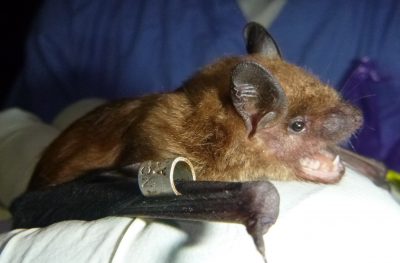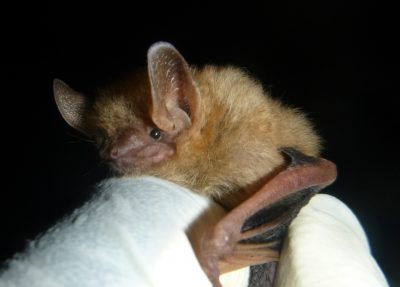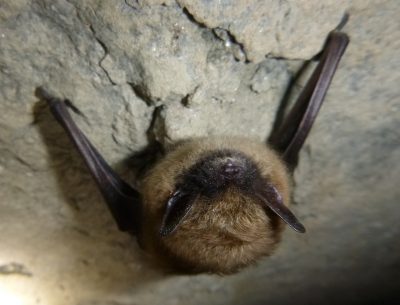The hypnotic hymn of the cicadas has been fading like a dying wind each evening as the air grows cooler with the arrival of autumn.
In the night sky, the Big Dipper, called the Celestial Bear in Micmac Native American legend, is spilling fall colors onto the foliage of trees.
Supporter Spotlight

Among the neighborhoods, seasonal decorations are blooming like the yellow goldenrod sprouting throughout the sand dunes and along the roadsides.
Halloween is on prominent display in some yards, with skeletons, ghosts, witches, monsters and bats creating spooky dioramas. Of all these goblins, the bat is the least scary to me.
In fact, bats are downright cool and have suffered for millennia from bad publicity. Bats are not blind, they are not rodents, they are not dirty, they do not attack people and they will not lay eggs in your hair no matter what Barney Fife said on the “Andy Griffith Show.”
Also, they do not want to bite you on the neck and suck your blood, well, unless you are a cow living in Latin America.
There are more than 1,300 species of bats throughout the world with 17 species in North Carolina. Among mammals, they are the only species that can take to wing and fly. Along the coastal plain and the barrier islands, the eastern red, evening, big brown, tri-color and Seminole bats are most common.
Supporter Spotlight
I remember as a young boy waiting on muggy summer evenings for the flickering mercury-vapor streetlights to illuminate their greenish glow under a darkening sky. Soon, the insects, mesmerized by the light, would swirl around like clouds of a gathering storm. Then, the bats would show up, zipping in and out of the curtain of darkness surrounding the light, gobbling up the bugs.
All the bat species in North Carolina are insect eaters and one bat can consume thousands in just one night. Without the bats, think of all the extra mosquitos buzzing around looking for exposed flesh. Mosquitos are the ones that want to drink your blood, not bats. Bats leave their roosting sites at dusk and head out to forage for insects throughout the night. Some bat species prefer terrestrial insects, some like aquatic insects and some consume both.
Many of these insects are not only the irritating pests that buzz around our heads, but they also are like flying teeth that take a big financial bite out of agricultural operations. As a natural pesticide, it is estimated that bats save around $3 billion annually on pest-control activities and reduce damage to crops.

Bats are agile pilots and use their echolocation system to navigate and locate prey. Their flight may look erratic and spastic as they nimbly maneuver after prey that are desperate to escape. Their flight is powered by wings that are pretty much like our hands with webbing between the fingers. To catch a bug, they emit a high-frequency vibration from their throat and nose. This sound wave then bounces off an insect, which the bat can hear with its ears. It can then pinpoint the size and location of the insect and close in for the capture.
As mentioned earlier, bats are not blind, contrary to the old saying “blind as a bat.” This adage has been credited to the philosopher Aristotle when he penned, “For as the eyes of bats are to the blaze of day, so is the reason in our soul to the things which are by nature most evident of all.” With apologies to Aristotle, most bats have good vision and use their sight when flying beyond the reach of their echolocation abilities.
Bats are in trouble though. Loss of habitat through development and human activities, the use of pesticides limiting their food source, disease and the outright killing of bats are taking its toll. In North Carolina, three species are listed as endangered, one is threatened and a few others are listed as special concern.
One disease in particular is devastating some bat species. The fungus Pseudogymnoascus destructans, is the cause of a disease called white-nose syndrome, which was detected in North Carolina in 2011. This fungus will grow on the exposed skin of bats, their nose, ears and wings, causing tissue damage. The disease also causes them to become active during winter hibernation. Bats rely on their body fat to provide just enough energy while at rest during hibernation to hold them over until they emerge when food sources become available. This activity causes them to use twice as much energy during a time of year when they are not feeding. Burning these fat reserves leads to starvation and dehydration.
The fungus favors damp temperatures ranging from 54 to 67 degrees Fahrenheit and is transmitted by contact. The disease easily spreads when bats congregate in proximity to roost and hibernate in cool moist places like caves. Bats can live 10 to 20 years, but since they usually have only one pup a year, this disease can cause localized populations to disappear quickly. In North Carolina, the disease is mostly in the mountains and the Piedmont without yet being detected on the coast.
Even though misleading myths and superstitions continue to swirl around them, bats do have a few champions. Dr. Matina Kalcounis-Rüeppell, professor and department head of biology at the University of North Carolina Greensboro, has been studying bats for more than 25 years after spending a summer assisting with bat research as a young undergraduate student.
One of her studies focused on the relationship between water quality and the feeding behavior of bats in the Piedmont region of North Carolina. Bat feeding activity was monitored upstream and downstream along a creek where effluent was discharged from a wastewater treatment plant. Nutrient levels downstream from the discharge resulted in poor water quality. Bats were observed feeding on insects above and below the discharge area. Of the five bat species present, one species favored foraging for insects in the area of poor water quality, two species avoided the area of poor water quality and two species did not have a preference.

“Bats respond to water quality,” says Kalcounis-Rüeppell. Her study suggests that patterns of feeding activity by certain bat species may be a way to gauge the water quality in urban watersheds.
Ed Corey, inventory biologist with the North Carolina Division of Parks and Recreation, has been documenting bat activity within the state parks. Corey has spent many long nights setting up mist nets to capture and study the diversity of bats.
Since some bats are wary of the nets, Corey can also identify the different species through acoustical monitoring. Each bat species has a different signature call that is recorded and then identified. Corey is also looking for the presence of white-nose syndrome to determine whether the disease is spreading east. He relates the disease as an “intense athlete’s foot” that irritates the skin, resulting in itching that burns precious fat. He cautions that even though white-nose syndrome has not been documented on the coast, “lack of detection does not mean that it is not there.”
It is theorized that the coastal temperatures may be too warm for the fungus to thrive. Corey’s work documenting bats and other park flora and fauna contributes to the responsible development of park facilities and trails ensuring that species are not negatively impacted.
Spooky or not, bats are beneficial. Some bats prefer eating nectar, pollen or fruit, and thus, help pollinate plants and spread seeds. Even though we have our own Transylvania County in North Carolina, we do not have any of the three species of vampire bats.
Despite their reputation, the medical community is looking upon vampire bats favorably. An enzyme in their saliva, called desmoteplase, shows promise as a clot-busting drug for stroke patients. With a sense of humor, the researchers have named the drug Draculin in honor of Count Dracula. The use of their saliva also dispels the myth that all bats are carriers of rabies. Like a dog or cat, bats can catch rabies, but they are not naturally infected with the virus. Interestingly, the military experimented with a use for bats that is downright scary. During World War II, extensive research, called Project X-Ray, was conducted by the military to assess the feasibility of bats to deliver incendiary bombs into enemy territory.
Even the superhero Batman used the sinister reputation of bats as a weapon against his adversaries. In Detective Comics No. 33, 1939, Bruce Wayne stated, “So my disguise must be able to strike terror into their hearts. I must be a creature of the night, black, terrible … a … a … a bat! That’s it! It’s an omen. I shall become a bat!”
Even though bats are often referenced as evil, macabre and linked to the underworld, many cultures view bats positively. They represent happiness, good fortune, life, transition, rebirth and courage to face our darkest fears. Even with the good, I think it will be hard for bats to overcome their preconceptions. Any respectable Halloween story should probably have started out describing a dark and stormy night with flashes of lightening illuminating an abandoned mansion full of bats flowing out into a thick, low fog and flying above the silhouettes of shadowy mummies lumbering with outstretched arms. As the spooks and goblins venture out tonight looking for treats, I think a number of them will resent the good in bats and be dressed as the Caped Crusader.
How to Help Bats
- Protect and restore their habitats.
- Construct and install bat boxes.
- Do not disturb roosting bats.
- Do not use pesticides.
- Do not intentionally kill bats.
- Learn about bats and educate others.
- Support bat conservation organizations.










